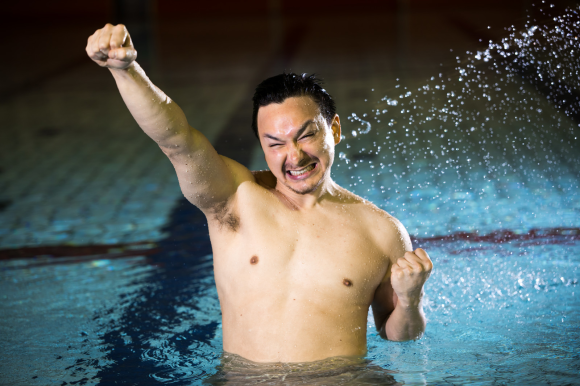
Scientists from Tokyo and Ibaraki discover there’s a cutoff point where kicking actually starts to slow you down.
Part of what makes swimming such great exercise is that it’s a whole-body workout. Especially if you’re swimming crawl (a.k.a. freestyle), you’re using your arms to stroke the water, your abs to rotate your core, and your legs to kick for added momentum.
Except, according to researchers in Japan, all that kicking might actually be slowing you down.
A team of researchers from Tokyo Institute of Technology and the University of Tsukuba (in Ibaraki Prefecture) recently performed an experiment. They had a swimmer hop into a water tank and swim crawl in two different ways, first by stroking with his arms and kicking, and next by using his arms without kicking. Then they measured the amount of drag/water resistance, and discovered that whether or not kicking is actually helping you move forward depends on the speed at which you’re swimming.
Specifically, if you’re swimming at a speed of 1.1 meters per second (which would allow you to swim 100 meters in 90.91 seconds), go ahead and kick. At that velocity, the kicking is having a positive effect on your total forward momentum.
However, if you’re a sufficiently speedy swimmer that you’re moving at 1.3 meters a second (or 100 meters in 76.92 seconds) or faster, the researchers found that kicking disrupts your body’s ability to glide smoothly through the water, and the increased drag will slow you down.
Now before you track down your swim school teacher from your childhood and yell at him for lying to you, there are a couple of things to keep in mind. First, a swimming speed of even 1.1 meters per second is pretty quick for an amateur athlete (average adult swimming speed is said to be around 0.9 meters per second). Second, the researchers were purely concerned with which technique produces more speed, not with which provides the better workout and fitness benefits. And finally, the experiment only examined the crawl, meaning the effect of kicking could be different for the breaststroke. Backstroke, and butterfly.
Still, if you’re a high-level competitor looking for freestyle victory in the pool, the experiment shows it’s better to let your arms pull you to glory, and just let your legs be along for the ride.
Sources: Asahi Shimbun Digital via Hachima Kiko, Journal of Biomechanics, Chron
Top image: Pakutaso
Follow Casey on Twitter, where he’s still sore from going to the pool last night.

 Japanese man goes missing at sea for 20 hours, then gets rescued by a lucky lifebelt
Japanese man goes missing at sea for 20 hours, then gets rescued by a lucky lifebelt Does running like Naruto really make you faster? A YouTube science channel investigates【Video】
Does running like Naruto really make you faster? A YouTube science channel investigates【Video】 Life-size giant freshwater stingray blankets to go on sale in Japan if enough people want them
Life-size giant freshwater stingray blankets to go on sale in Japan if enough people want them Cosplay in the pool with a swimming costume from popular anime High School Fleet
Cosplay in the pool with a swimming costume from popular anime High School Fleet 17 Mind-Blowing Facts About Russia
17 Mind-Blowing Facts About Russia McDonald’s new Happy Meals offer up cute and practical Sanrio lifestyle goods
McDonald’s new Happy Meals offer up cute and practical Sanrio lifestyle goods All-you-can-drink Starbucks and amazing views part of Tokyo’s new 170 meter-high sky lounge
All-you-can-drink Starbucks and amazing views part of Tokyo’s new 170 meter-high sky lounge Kyoto’s 100 Demons yokai monster parade returns!
Kyoto’s 100 Demons yokai monster parade returns! More foreign tourists than ever before in history visited Japan last month
More foreign tourists than ever before in history visited Japan last month Hamster abandoned at Tokyo ramen restaurant gets new home
Hamster abandoned at Tokyo ramen restaurant gets new home Studio Ghibli glasses cases let anime characters keep an eye on your spectacles
Studio Ghibli glasses cases let anime characters keep an eye on your spectacles Beautiful Sailor Moon manhole cover coasters being given out for free by Tokyo tourist center
Beautiful Sailor Moon manhole cover coasters being given out for free by Tokyo tourist center The oldest tunnel in Japan is believed to be haunted, and strange things happen when we go there
The oldest tunnel in Japan is believed to be haunted, and strange things happen when we go there Super Nintendo World expansion gets delayed for several months at Universal Studios Japan
Super Nintendo World expansion gets delayed for several months at Universal Studios Japan Rice bran, the skincare product used by Japanese women for centuries and now Chloë Grace Moretz
Rice bran, the skincare product used by Japanese women for centuries and now Chloë Grace Moretz Disney princesses get official manga makeovers for Manga Princess Cafe opening in Tokyo
Disney princesses get official manga makeovers for Manga Princess Cafe opening in Tokyo Starbucks reopens at Shibuya Scramble Crossing with new look and design concept
Starbucks reopens at Shibuya Scramble Crossing with new look and design concept Beautiful new Final Fantasy T-shirt collection on the way from Uniqlo【Photos】
Beautiful new Final Fantasy T-shirt collection on the way from Uniqlo【Photos】 Is the new Shinkansen Train Desk ticket worth it?
Is the new Shinkansen Train Desk ticket worth it? Foreign English teachers in Japan pick their favorite Japanese-language phrases【Survey】
Foreign English teachers in Japan pick their favorite Japanese-language phrases【Survey】 Japanese convenience store packs a whole bento into an onigiri rice ball
Japanese convenience store packs a whole bento into an onigiri rice ball We try out “Chan Ramen”, an underground type of ramen popular in the ramen community
We try out “Chan Ramen”, an underground type of ramen popular in the ramen community Studio Ghibli releases Kiki’s Delivery Service chocolate cake pouches in Japan
Studio Ghibli releases Kiki’s Delivery Service chocolate cake pouches in Japan Japan’s bone-breaking and record-breaking roller coaster is permanently shutting down
Japan’s bone-breaking and record-breaking roller coaster is permanently shutting down New definition of “Japanese whiskey” goes into effect to prevent fakes from fooling overseas buyers
New definition of “Japanese whiskey” goes into effect to prevent fakes from fooling overseas buyers Our Japanese reporter visits Costco in the U.S., finds super American and very Japanese things
Our Japanese reporter visits Costco in the U.S., finds super American and very Japanese things Studio Ghibli unveils Mother’s Day gift set that captures the love in My Neighbour Totoro
Studio Ghibli unveils Mother’s Day gift set that captures the love in My Neighbour Totoro Foreign passenger shoves conductor on one of the last full runs for Japan’s Thunderbird train
Foreign passenger shoves conductor on one of the last full runs for Japan’s Thunderbird train Domino’s Japan now sells…pizza ears?
Domino’s Japan now sells…pizza ears? New Japanese KitKat flavour stars Sanrio characters, including Hello Kitty
New Japanese KitKat flavour stars Sanrio characters, including Hello Kitty Kyoto creates new for-tourist buses to address overtourism with higher prices, faster rides
Kyoto creates new for-tourist buses to address overtourism with higher prices, faster rides Sales of Japan’s most convenient train ticket/shopping payment cards suspended indefinitely
Sales of Japan’s most convenient train ticket/shopping payment cards suspended indefinitely Sold-out Studio Ghibli desktop humidifiers are back so Totoro can help you through the dry season
Sold-out Studio Ghibli desktop humidifiers are back so Totoro can help you through the dry season Japanese government to make first change to romanization spelling rules since the 1950s
Japanese government to make first change to romanization spelling rules since the 1950s Ghibli founders Toshio Suzuki and Hayao Miyazaki contribute to Japanese whisky Totoro label design
Ghibli founders Toshio Suzuki and Hayao Miyazaki contribute to Japanese whisky Totoro label design Doraemon found buried at sea as scene from 1993 anime becomes real life【Photos】
Doraemon found buried at sea as scene from 1993 anime becomes real life【Photos】 Tokyo’s most famous Starbucks is closed
Tokyo’s most famous Starbucks is closed One Piece characters’ nationalities revealed, but fans have mixed opinions
One Piece characters’ nationalities revealed, but fans have mixed opinions We asked a Uniqlo employee what four things we should buy and their suggestions didn’t disappoint
We asked a Uniqlo employee what four things we should buy and their suggestions didn’t disappoint Princesses, fruits, and blacksmiths: Study reveals the 30 most unusual family names in Japan
Princesses, fruits, and blacksmiths: Study reveals the 30 most unusual family names in Japan Japanese paralympic athlete plays emotive violin piece using her prosthetic arm as the bow【Video】
Japanese paralympic athlete plays emotive violin piece using her prosthetic arm as the bow【Video】 The 10 best hotel hot springs in Japan, as chosen by Japanese travelers
The 10 best hotel hot springs in Japan, as chosen by Japanese travelers Japan’s new wearable air conditioner belt is here just in time for the Tokyo heat wave
Japan’s new wearable air conditioner belt is here just in time for the Tokyo heat wave Spirited Away’s No Face appears on new ramen bowls and tableware by Studio Ghibli
Spirited Away’s No Face appears on new ramen bowls and tableware by Studio Ghibli The new “Snow Turtle” train is slower than running, but at least you won’t get tired
The new “Snow Turtle” train is slower than running, but at least you won’t get tired Three bridges in Okinawa Prefecture offer the most spectacular panoramic vistas of the sea【Pics】
Three bridges in Okinawa Prefecture offer the most spectacular panoramic vistas of the sea【Pics】 How to hatch your Pokémon GO eggs without any walking by using a handheld massager【Video】
How to hatch your Pokémon GO eggs without any walking by using a handheld massager【Video】 Cup of noodles for vegans! Japanese Zen Buddhist temple starts selling instant soba and udon
Cup of noodles for vegans! Japanese Zen Buddhist temple starts selling instant soba and udon Enjoy a relaxing bowl of tea with these beautiful goldfish-shaped teabags from Taiwan
Enjoy a relaxing bowl of tea with these beautiful goldfish-shaped teabags from Taiwan This shrine in Japan looks too beautiful to exist in our world
This shrine in Japan looks too beautiful to exist in our world Can these swimsuit clad cosplay waitresses interest you in some “Shaved Leg Hair Pasta”?
Can these swimsuit clad cosplay waitresses interest you in some “Shaved Leg Hair Pasta”? Endangered critters in China get health check, diagnosed with acute cuteness 【Photos】
Endangered critters in China get health check, diagnosed with acute cuteness 【Photos】 Effect of Dragon Ball-style Gravity Chamber on training studied at Chubu University
Effect of Dragon Ball-style Gravity Chamber on training studied at Chubu University 6.6-foot-wide rideable Lapras sofa: The plushie Pokémon furniture adult fans have been hoping for
6.6-foot-wide rideable Lapras sofa: The plushie Pokémon furniture adult fans have been hoping for Crotch improvement makes Japan’s new 2019 Damegi roomwear lazier and cozier than ever【Photos】
Crotch improvement makes Japan’s new 2019 Damegi roomwear lazier and cozier than ever【Photos】
Leave a Reply